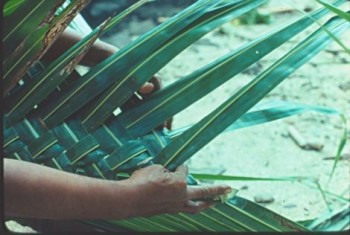
Micronesia's clan chiefs weave peaceful relations among the region's communities in much the same way that they weave food baskets for their people, and in the ways sorcerers weave peace-keeping spells. Here the chief of Upper Awak on Pohnpei, in the midst of a tribute feast, weaves the baskets in which his people will carry home the food they have just presented to him at the feast.
The Pig in a Garden: Jared Diamond and The New Yorker Series
Art Science Research Laboratory’s imediaethics.org is publishing a series of essays on the controversy surrounding Jared Diamond’s New Yorker article, “Annals of Anthropology: Vengeance is Ours.” The essay series titled,The Pig in a Garden: Jared Diamond and The New Yorker, is written by ethics scholars in the fields of anthropology and communications, as well as journalists, environmental scientists, archaeologists, anthropologists and linguists et al., and edited by Rhonda Roland Shearer, Alan Bisbort and Sam Eifling. *Note: Savage Mind people are leaving for the summer for research and find themselves unable to keep up with posting essays of , what has turned out to be, more contributors than anticipated. imediaethics.org will continue the series with the same editors. Alex Golub will comment from Papua New Guinea as time allows. Petersen’s essay is the fourth in the series.*
One conclusion an attentive reader might draw from Jared Diamond’s observations about cycles of violent revenge among New Guinea societies is that in the absence of political organizations of the sort that scholars term “states” – with their formal, centralized governments – humans are pretty much incapable of avoiding or preventing such repetitive progressions of violence. He writes: “Modern state societies permit and encourage us to express our love, anger, grief and fear, but not our thirst for vengeance. We grow up being taught that such feelings are primitive, something to be ashamed of and to transcend.” (It should probably be pointed out in this context that most — if not all — human societies are conflicted when it comes to emotions or drives such as vengeance, tending both to reject and encourage them.) Diamond concludes that it is only because we (that is, we who live in societies that publish and read magazines like The New Yorker) have granted the state a monopoly over violence that we are free from the scourge of endless revenge: “Otherwise, we, too, would be living under the conditions of constant warfare prevailing in non-state societies like those of the New Guinea Highlands.”
Given Diamond’s premises, this would seem to be logical, but it is hardly in keeping with what field anthropologists know about the history of human societies. Diamond casually generalizes from New Guinea to the rest of the world, as if all societies without state forms of government have been hobbled by essentially the same constraints. New Guinea specialists can and will dispute his evidence and conclusions about populations on that island. But my own knowledge is keenest regarding the island societies of Micronesia, especially the Eastern Caroline Islands, a few hundred miles due north of New Guinea, and I intend to challenge Diamond’s conclusions by drawing upon the materials on which I base my book, Traditional Micronesian Societies: Adaptation, Integration, and Political Organization in the Central Pacific, forthcoming from the University of Hawaii Press.
Micronesia’s Matrilineal Clans
Nearly all island societies of Micronesia are characterized by the presence of dispersed matrilineal clans. It is possible that the antecedents of these clans were first carried into the region by settlers sailing north from eastern Melanesia (some argue that the early Austronesian societies that first moved from the New Guinea coast into eastern Melanesia were matrilineal; I’m unconvinced), but they appear to have developed their characteristic dispersed form in the Eastern Carolines, then spread east into the Marshall Islands and westward across the central Pacific to Belau and the Marianas. The character of these kin groups is remarkably similar on islands ranging across 3,000 miles of ocean, and it is likely that this form of social relations succeeded as well as it did because of its highly adaptive qualities.
In a nutshell, dispersed matrilineal clans mean that all Micronesians are born into their mothers’ kin groups, and that each person is simultaneously a member of both a small local branch of this group – that is, a lineage – and a much larger clan with member lineages on many different islands. This is what makes Micronesia’s clans particularly distinctive and explains why they are described as dispersed: Each clan has multiple lineages, settled in different communities and on distant islands. And each community and each island, in turn, has lineages from many different clans residing in it.
This social structure perhaps owes to climate and geography. All of Micronesia is susceptible to the ravages of annual typhoons, and most of the islands are low-lying coral atolls that are especially vulnerable to these powerful storms. Micronesian peoples (with exceptions on some of the larger islands) excel at navigation, and the dispersed matrilineal clans have made it possible for the people of a community that has been devastated by a catastrophic storm to relocate temporarily to adjacent communities, and what is more important, to do so safely. In theory, several options are open to communities devastated by a typhoon. They can sail to another island and throw themselves at the mercy of its people – but they might then run the risk of enslavement or some comparable form of subordination. They might conceivably invade another island and attempt to seize it from its inhabitants – but a group that had just survived a typhoon would ordinarily be in no condition to mount a successful act of aggression. If, however, each family in every community in the region were to have multiple ties of kinship with families on surrounding islands, then whenever disaster struck, people might simply pick up and move in with relatives living elsewhere, and shelter with them until they rehabilitated the gardens on the island they fled.
This is precisely what Micronesia’s dispersed clans accomplish. Survival on these typhoon-prone islands is underwritten by this extraordinarily practical system of human relations. Having recognized that conditions in their islands are precarious, the modern Micronesians’ ancestors opted to establish and maintain relationships that emphasized cooperation and mutual reliance. They seem to have done this in response to the realization that the alternative was endlessly cycling violence.
Rendering Pursuit of Vengeance Unnecessary
Micronesians traditionally engaged in combat, of many sorts, and for many reasons, but it was not their first means of dispute resolution. To this day, nearly every Micronesian community practices dances with staves and spears, in routines closely resembling close-order drills or martial arts; these performances effectively communicate a community’s preparedness to fight. In some Micronesian societies combat was most likely to consist of lines of warriors facing off against one another, hurling insults and occasionally spears, until someone was injured, at which time the matter would be concluded. On the island of Yap, the outcomes of battles were sometimes fixed in advance. And sometimes Micronesians did stage invasions and attacks, and engage in conquest and mayhem. These acts of violence served to remind people what life would be like if they could not find alternative ways of resolving their differences.
Micronesians’ dispersed clans rendered endless disputes in pursuit of vengeance unnecessary, and allowed them instead to find relatives everywhere, people on whom they could unquestioningly rely for support and succor. More to the point, however, these dispersed kin groups also made it possible for them to short-circuit patterns of revenge before they fully developed.
On the island of Pohnpei, where I have been doing ethnographic research for 35 years, people have explained to me that in the past (that is, before colonial governments imposed new rules and laws), when there was a homicide in which a person from one community slew someone from another community, their elders would take deliberate steps to prevent violence from spiraling out of control. The victim’s community would determine the clan membership of the slayer. Then they would choose a member of their own community who belonged to the same clan. This man would be sent to exact retribution by killing the perpetrator. Because this second homicide was between members of the same clan, it would bring any potential cycling of the violence abruptly to a halt. No further acts of retribution were called for, and the bloodshed was expected to fade away.
The people of Pohnpei continue to employ other means of cutting short possible cycles of vengeance. Perhaps the most striking of these is the tohmw ceremony, the formal apology. On Pohnpei, as in many other parts of the western Pacific, the people prepare and imbibe juice from the root of a species of pepper plant (Piper methysticum), widely called kava (known on Pohnpei by a cognate term, sakau). Pohnpeians consider kava to be a sacred plant. The ritual preparation of it and the ceremony of drinking it are sacrosanct. Its spiritual power is so great, in fact, that when a cup of kava is offered in the form of apology, neither the cup nor the apology should be refused. When an act of violence (or in some cases even an accidental injury) is committed, the family and community of the perpetrator, represented by their chief, can choose to approach the victim’s family, community, and chief and formally apologize by preparing kava and offering it as atonement. This is the tohmw, and in all but the most unusual circumstances it is accepted. Acceptance of this formal apology does not, of course, immediately allay the animus, and perhaps even the wish for revenge, but the extraordinarily sacred character of the kava that has been offered and accepted demands that peace maintained, at the risk of dire supernatural consequences (riala).
It sometimes happens that a young man, in drunken fury, attacks another and kills him (young Pohnpeian men spend a great deal of time tending crops and habitually carry machetes with them). Pohnpeians believe that drunks are not entirely responsible for their actions, but that their families and lineages do bear some responsibility. The perpetrator’s family may, under some circumstances, include in the process of the tohmw apology an offer to have their son go to live with the victim’s family, in order both to replace the labor that was lost and to have the young man experience personally the agony of the family that lost a son to his reckless act.
I know firsthand of a homicide in the 1990s that, because of its gory details, was particularly upsetting to the victim’s community. Tensions ran extremely high — people told me they had never seen such stress – and the potential for further violence was palpable. Calm was eventually restored and peaceful resolution was achieved, but it was common knowledge in the community at the time that retaliatory bloodshed was averted only because sorcerers had been enlisted to cast a series of traditional binding spells that held people’s immediate, violent impulses in check and promoted cool, reasonable discourse, and slow, deliberate reconciliation.
Potential for Violence Acknowledged
In traditional Micronesian societies, people have had very clear notions about the potential for violence in their day-to-day lives, about their vulnerability to it, and about the possibilities of preventing, avoiding, or quickly ending it. This does not mean that they were always able to avoid violence (or that they wanted to), consistently achieved nonviolent resolutions to disputes, or that they successfully averted all acts of vengeance. Indeed, it was only because some times, in some cases, and with some individuals, these values and practices did not prevail, that they fully understood just how threatening cycles of violence could be, and worked assiduously to create means for thwarting them.
I have little doubt that some scholars will dispute my conclusions, and argue that traditional Micronesian societies were more violence-prone than I represent them to have been. But my goal here is not to assert my perspective absolutely. I simply wish to show that Micronesians recognized the threat that cycles of vengeance posed to their survival and had means of dealing with them. They were not helplessly ignorant of the potential for these cycles to spiral out of hand, nor were they without means of grappling with them. Whether they always succeeded in doing so is hardly the issue, given the prevalence of wars among the 20th century Europeans that Diamond seems to be holding up as paragons of enlightened behavior. Micronesians, and others, were for the most part neither more nor less able to understand human propensities for violence and to compensate accordingly. Scholars who have devoted their lives to studying the dynamics of clan-organized societies have arrived at conclusions significantly at odds with Diamond’s. Readers should be aware that his conclusions are his alone, and not those of professional anthropologists.
Glenn Petersen first traveled to the Western Pacific at age 19 when he was sent to fight in Vietnam. It was in the course of the war that he decided to become an anthropologist, and he opted, as a result of his experiences, to study American colonialism in the Pacific. He has been conducting ethnographic research in the Micronesian islands since the early 1970s, and worked alongside Micronesians in their pursuit of autonomy and self-government. He served for a time as a member of the Federated States of Micronesia’s Permanent Mission to the United Nations. He is Professor of Anthropology and International Affairs at Bernard Baruch College and the Graduate Center of the City University of New York, and Chair of the Sociology and Anthropology Department at Baruch. His books on Micronesia include One Man Cannot Rule a Thousand (1982), Lost in the Weeds (1990), Ethnicity and Interests at the 1990 Federated States of Micronesia Constitutional Convention (1993), and Traditional Micronesian Societies (2009).






Comments Terms and Conditions